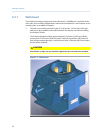
• All process signal wiring should be of a single, continuous length between field
devices and the GC. If, however, the length of the conduit runs require that multiple
wiring pulls be made, the individual conductors must be interconnected with
suitable terminal blocks.
• Use suitable lubrication for wire pulls in conduit to prevent wire stress.
• Use separate conduits for AC voltage and DC voltage circuits.
• Do not place digital or analog I/O lines in the same conduit as AC power circuits.
• Use only shielded cable for digital I/O line connections.
- Ground the shield at only one end.
- Shield-drain wires must not be more than two AWG sizes smaller than the
conductors for the cable.
• When inductive loads (relay coils) are driven by digital output lines, the inductive
transients must be diode-clamped directly at the coil.
• Any auxiliary equipment wired to the GC must have its signal common isolated from
earth/chassis ground.
WARNING!
Any loop of extra cable left for service purposes inside the GC purged housing must not be
placed near the conduit entry for AC power. This applies to all digital and analog I/O lines
connecting to the GC. If the above precaution is not followed, the data and control signals to
and from the GC can be adversely affected.
3.3.3 Electrical and signal ground
Follow these general precautions for grounding electrical and signal lines:
• For shielded signal conducting cables, shield-drain wires must not be more than two
AWG sizes smaller than the conductors for the cable. Shielding is grounded at only
one end.
• Metal conduit used for process signal wiring must be grounded at conduit support
points (intermittent grounding of conduit helps prevent induction of magnetic
loops between the conduit and cable shielding).
• A single-point ground must be connected to a copper-clad, 10-foot long, 3/4-inch
diameter steel rod, which is buried, full-length, vertically into the soil as close to the
equipment as is practical.
Note
The grounding rod is not furnished.
Installation and setup
34


















